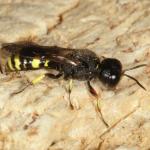Crabro larvatus (WESMAEL,1852); Crabro microstictus (HERRICH-SCHÄFFER,1841); Crabro pumilus (COSTA,1871)
One of the smaller Ectemnius species, resembling a small E. continuus, but much less frequent.
Widely recorded in southern England as far north as Northamptonshire and west to Dorset and Somerset. There are several records for the south coast of Wales, but the wasp is unknown from the south-west of England. Recorded from Europe, North Africa, Caucasus, Kazakhstan, north-eastern China and Japan.
Not listed in Shirt (1987) or Falk (1991) Generally scarce and infrequent. This species is probably not threatened and appears to have increased slightly in frequency during recent decades.
Recorded from a variety of habitats including coastal and urban areas. Perhaps most frequent in rough grassland, tall herbs and open scrub.
Univoltine; May to September, with most records between June and August.
Prey consists of flies including syrphids, muscids, lauxaniids, tephritids and acrocerids (Lomholdt, 1975-76).
This is the only member of the genus which regularly nests in hollow plant stems as opposed to dead wood. Records include the stems of thistles, bramble and common reed. Up to 17 cells are placed successively in the stem, using material such as plant fragments to create partitions. E. rubicola has been reported sharing stems with other wasps such as Trypoxylon species and Ancistrocerus trifasciatus (Lomholdt, 1975-76).
Umbellifers such as wild carrot, hogweed, wild parsnip and hedge-parsley.
No information available.
1998


